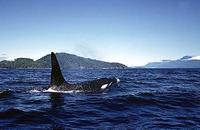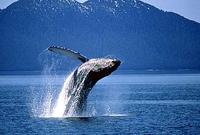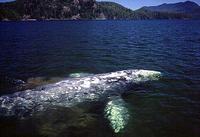Whale
WHALE is the common name for a number of species of marine mammals of the order Cetacea. There are 2 suborders: Mysticeti, the toothless or baleen whales (filter feeders), and Odontoceti, the toothed whales, which include DOLPHINS and PORPOISES. Many species of whales once visited the BC coast, but a commercial hunt that began in the Pacific in the mid-19th century drastically depleted their numbers (see WHALING). Today 4 species are present in significant numbers: the gray, humpback and minke whales, which are all baleen whales, and the KILLER WHALE, a member of the dolphin family.
Gray whales (Eschrichtius robustus) breed in warm-water lagoons in Baja California and each spring migrate north along the coast to their summer feeding grounds off Alaska. The round trip, about 16,000 km, is one of the longest annual migrations of any mammal. The whales pass by the west coast of VANCOUVER ISLAND between March and May, supporting an active WHALE WATCHING industry based in TOFINO and UCLUELET. Grays subsist mainly on amphipods (tiny crustaceans). They grow to 36 tonnes and to 15 m in length, and they live an average of 30 to 40 years. They were valued by hunters for their oil and for the strips of baleen with which they strain food from sea water. Prior to the invention of plastic, baleen was used in manufacturing a wide range of products. A commercial hunt began in Baja in 1845 and the herd of about 20,000 animals was depleted to about 2,000 by 1880. Occasional hunting continued to 1937, when the gray became a protected species. Much to everyone's surprise the population recovered from the devastation of the hunt and apparently had regained its pre-hunt size by the late 1990s. A number of gray whales spend the summer in the nearshore waters of the BC coast, including the vicinity of PACIFIC RIM NATIONAL PARK, and occasionally a gray strays into GEORGIA STRAIT and the INSIDE PASSAGE.
Humpback whales (Megaptera novaeangliae) grow to 18 m in length and weigh up to 41 tonnes. They have long flippers that have been compared to wings. Humpbacks feed mainly on EUPHAUSIIDS but also on HERRING and sand lance (an eel-like fish). They often feed by deploying a "bubble net" as they rapidly circle their prey while exhaling, then swoop up from below with their mouths open. The North Pacific population of humpbacks is estimated at 10,000; over 5,400 individuals have been identified in BC. Each whale has a unique pattern of coloration on the underside of its fluke that can be used for identification. Humpback populations are coming back strongly after being devastated by whaling. The North Pacific population breeds near Hawaii and to a lesser extent Japan between Jan and Apr, then spends the rest of the year off the west coast of N America. On the breeding grounds, males sing long, distinctive songs.
Minke whales (Balaenoptera acutorostrata) are the smallest of the baleen whales in BC waters, reaching a length of about 10 m and a weight of about 7 tonnes. With a dark back and a small curved dorsal fin, the minke is inconspicuous and is often missed as it travels through JUAN DE FUCA STRAIT and adjacent waters. When feeding actively on fish, it may show a pointed snout and white bars on the fins. Little is known about minke movement patterns but the whales are seen on the coast throughout the year, usually travelling alone and often feeding in tide rips.
Reading: David A.E. Spalding, Whales of the West Coast, 1999.



